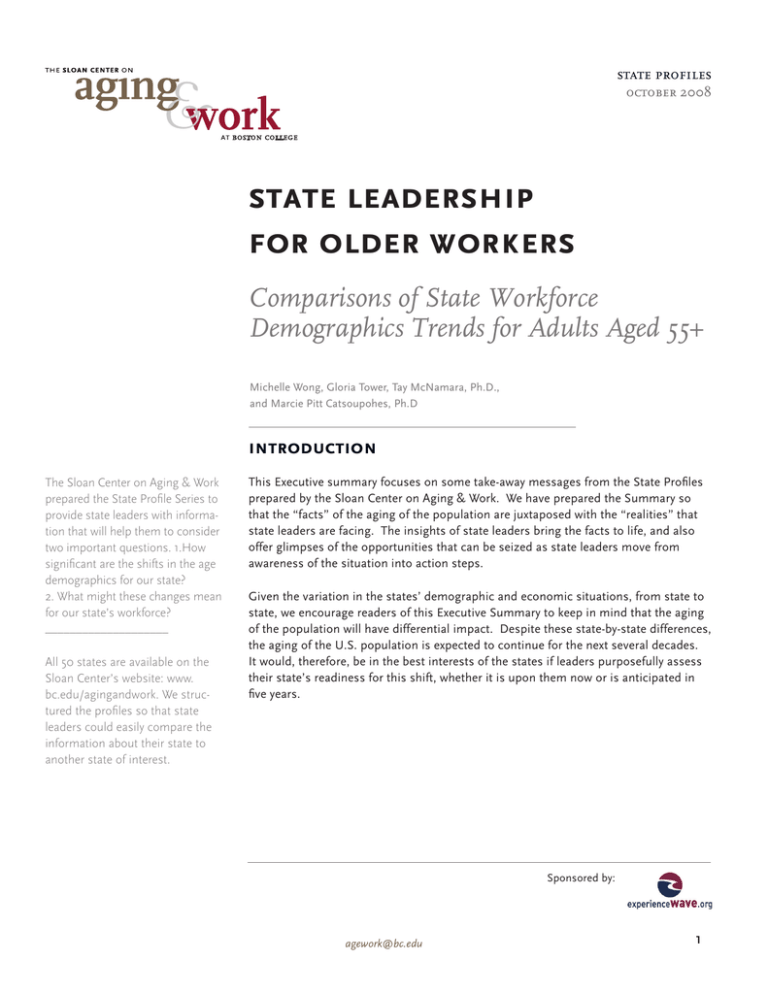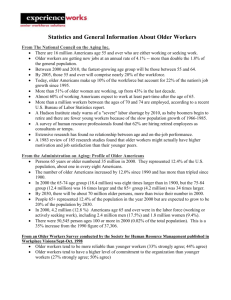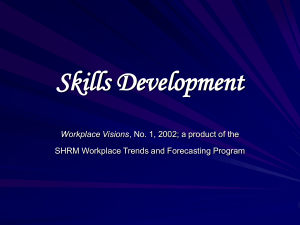state leadership for older workers Comparisons of State Workforce
advertisement

state profiles state profiles october 2008 october 2008 state leadership for older workers Comparisons of State Workforce Demographics Trends for Adults Aged 55+ Michelle Wong, Gloria Tower, Tay McNamara, Ph.D., and Marcie Pitt Catsoupohes, Ph.D introduction The Sloan Center on Aging & Work prepared the State Profile Series to provide state leaders with information that will help them to consider two important questions. 1.How significant are the shifts in the age demographics for our state? 2. What might these changes mean for our state’s workforce? ____________________ All 50 states are available on the Sloan Center’s website: www. bc.edu/agingandwork. We structured the profiles so that state leaders could easily compare the information about their state to another state of interest. This Executive summary focuses on some take-away messages from the State Profiles prepared by the Sloan Center on Aging & Work. We have prepared the Summary so that the “facts” of the aging of the population are juxtaposed with the “realities” that state leaders are facing. The insights of state leaders bring the facts to life, and also offer glimpses of the opportunities that can be seized as state leaders move from awareness of the situation into action steps. Given the variation in the states’ demographic and economic situations, from state to state, we encourage readers of this Executive Summary to keep in mind that the aging of the population will have differential impact. Despite these state-by-state differences, the aging of the U.S. population is expected to continue for the next several decades. It would, therefore, be in the best interests of the states if leaders purposefully assess their state’s readiness for this shift, whether it is upon them now or is anticipated in five years. Sponsored by: agework@bc.edu 1 which states have the highest percentage for their populations aged 55 and older? Figure 1:States with Highest and Lowest Percentages of Population 55+ (2006) Compared to the U.S. Percentage 30.0% 28.1 28.0 27.3 26.5 26.1 23.0 25.0% 20.2 19.7 20.0% 19.1 16.7 16.7 15.0% 10.0% 5.0% 0.0% Florida Pennsylvania California Alaska West Virginia Montana Georgia Utah Maine United States Texas Source: American Community Survey, 2006 The aging of the population is a national trend. Florida is the state with the highest percent of its population age 55 and older, followed by West Virginia, Maine, Pennsylvania, and Montana. ÂÂ Questions for State Leaders If adults aged 55 and older comprise a relatively high percentage of your state’s population, how might they contibute to the quality of life enjoyed by state residents? What are the possible implications for emergent needs and expectations for state resources? 2 http://www.bc.edu/agingandwork state profiles october 2008 West Virginia Tom Dudley, Director Senior Community Service Employment Program Much of the employment success of West Virginia’s older adults is based on West Virginians’ attitude about employment as opposed to our ability to assist people in finding jobs. There is a very high work ethic in West Virginia and economic studies in the state show a high interest in working as long as possible. In fact, a study in 2000 illustrated that 6,000 West Virginians 75 years of age and older were still employed in the state and 400 more wanted to find jobs.1 So West Virginians enjoy working for as long as they can. As the state prepares for the retirement of its baby boomers, older West Virginians are the state’s most viable workforce. There is little migration into the state and younger West Virginians tend to leave for more professional careers. Therefore, the state needs to capitalize on its older workforce to fill the employment gap that will be left by the retirees. West Virginian businesses tend to be small and run by 1-2 people, so an exciting trend emerging in state employment programs is to educate older adults about ways to turn their hobbies into career opportunities. Also, the West Virginia legislature is becoming more astute to aging issues and increasingly appreciative of both the value and challenges of an aging state. The legislature is educating itself through interim committees (such as the Select Committee on Senior Citizens, Long-Term Care and PEIA) that meet outside of the typical 60day legislative session. These committees agework@bc.edu focus on issues that are prevalent within the legislature in order to become more acquainted with aging issues within the state. There is not much legislative activity for older adults within the workforce at this time and one reason for this is that older adults are not always seen as valuable to the workforce. There has been a great deal of legislative activity around home care services, Medicaid, and dementia; however, a growing demand in the state to fill jobs is changing the way older adults are perceived. For example, our office encourages computer learning for all older people because entry level jobs are not keeping the young workforce engaged. Older adults are often interested in taking these jobs but often do not want, nor need, to work a traditional full-time, 9-5 schedule. So, more flexibility is needed to keep older adults in these jobs because they are often not solely dependent upon this one job. Also, older adults are often not as interested in the fringe benefits that attract younger workers because they are no longer planning for the next 30 years. Employers need to develop benefit plans that align with more of what older workers need, such as flexible scheduling and creative healthcare offering; so I think we will see more of this activity within the legislature as these issues become more and more relevant to the workforce of West Virginia. 3 which states are expected to see the greatest percentage point increase in those who are 55 and older between 2006 and 2010? Figure 2:States with Highest and Lowest Percentage Point Increase in the 55+ Population (2006-2010) Compared to the Percentage Point Change in the U.S. 5.0% 4.6 4.3 4.0% 3.3 3.0% 3.1 3.0 1.8 2.0% 1.4 1.0% 1.1 1.1 1.0 -0.1 0.0% -1.0% Wyoming Montana Georgia North Carolina New Mexico Florida Maryland District of Columbia Arkansas United States Utah Source: American Community Survey, 2006 and U.S. Census Bureau, 2000 and 2005 In 2006, 10 states had populations with at least 25% of residents aged 55 or older. According to the US Census Bureau, that number will increase to 31 states by 2010. Wyoming is expected to have the largest percentage point increase of people aged 55 and older, followed by New Mexico, Montana, Florida, and Arizona. ÂÂ Questions for State Leaders Have leaders in your state been monitoring changes in the age demographics over the past decade? Are they taking steps to consider these changes that will take place over the next decade? 4 http://www.bc.edu/agingandwork state profiles october 2008 Florida E. Douglas Beach, PhD, Secretary Florida Department of Elder Affairs Florida’s demographics suggest that the state is about to go through a similar workforce upheaval as we did in the 1960s when women entered the workforce in high numbers and we adapted to a new type of person in the labor force. Currently, there are not enough younger workers in the pipeline to replace retirees, and at the same time the money in 401K plans and Social Security do not offer individuals the opportunity to live the way they want. In Florida, we consider this a virtuous cycle rather than a perfect storm – it’s an opportunity to make things better in America. Florida is actively working to bring together minds on the topic of older workers and are brainstorming numerous exciting policies and programming. For instance, we are considering putting together a web-based program of senior friendly businesses where older adults could post their resumes, and businesses could post available paid and unpaid work opportunities. Florida is also considering awards to businesses that provide employment services to older adults. We are also actively working to change the misconception that older adults require retraining to enter new jobs, because everyone requires retraining with every new job he or she begins. In addition, we are encouraging employers to challenge their bias toward younger agework@bc.edu workers when filling vacant positions and to consider instead the productivity and reliability older workers promise. Florida is also considering ways for older adults to remain in their current place of employment by creating more flexibility for older workers to take “back steps” into roles that are less demanding without the stigma often attached to movement such as this in the workplace. We are also hoping to develop satellite Life Long Learning Institutes in residential facilities for older adults, which would offer courses relevant to the needs of the current job market and would provide scholarship opportunities for older adults interested in participating. Through our federally funded Senior Community Services Employment Program (SCSEP), Florida is concentrating much effort on outreach to businesses to make them keenly aware that older adults are a labor base that employers need to tap into. We are encouraging businesses to offer increased flexibility and benefits to attract older adults and we’re promoting a positive message about the value of older workers so that employers consider older workers an asset to the community rather than a liability. 5 in which states are the employment rates for older adults the highest? Figure 3:States with Highest and Lowest Employment Rates of Adults 55+ Compared to the U.S. Rates in 2006 50.0% 46.8 44.0 42.9 41.7 41.6 40.0% 35.0 30.7 30.7 30.3 30.2 30.0% 26.8 20.0% 10.0% 0.0% Wyoming New Hampshire Mississippi Florida Alaska South Dakota Alabama West Virginia Nebraska United States Kentucky Source: American Community Survey, 2006 The labor force participation rate in Wyoming for people aged 55 and older is 46.8%. This is the highest rate for older adults in the country. ÂÂ Questions for State Leaders Have leaders in states with relatively high rates of employment determined whether the jobs assumed by older workers fit with their priorities and needs? Do the employment opportunities include some jobs appropriate for older adults transitioning from a “career job” into a “retirement job”? 6 http://www.bc.edu/agingandwork state profiles october 2008 Wyoming Rob Black, Leader National Governors Association (NGA) team & Grants Coordinator Department of Workforce Services Wyoming was one of eight states recently chosen to receive assistance on older worker issues by the National Governors Association (NGA), offering workshops, seminars and resources aimed at helping states more fully engage older adults in the workforce and civic volunteerism. A ninemember public-private team was formed in 2007 to examine the issues surrounding older workers and influence policy. Given that state government is the largest employer in Wyoming, the NGA team adopted a goal of making the state a model employer of older workers by adopting innovative employment practices. The team is working in partnership with state agency directors and human resource teams to encourage workplace polices that benefit all workers, while keeping in mind the unique needs and value of older workers. The team will begin trainings in Fall/ Winter 2008 with managers and supervisors of several state agencies, where policy implementation occurs. These trainings aim to encourage managers to recognize established policies, such as flexible scheduling, telecommuting and four-day work agework@bc.edu weeks, while particularly focusing on the merit of hiring older workers with success stories from the private sector. The NGA team also has plans to work closely with workforce centers throughout the state to ensure that all field staff are trained to provide a link between older workers and businesses seeking employees. Following Arizona’s example, this past year Wyoming also developed an Older Worker Friendly Award for private sector businesses. The award aims to encourage older worker friendly businesses, and to bring older worker issues more into the mainstream, rewarding businesses that pass the “friendly test” with a certificate from the Governor they can use for marketing and recruiting purposes. The NGA team is currently brainstorming multi-media training possibilities – such as an online or face-to-face course, a DVD, and partnerships with local community colleges – for businesses who apply for an Older Worker Friendly certificate. Certificate recipients are automatically eligible for the annual Older Worker Friendly Award. 7 which states have the highest unemployment rates for people aged 55 and older? Figure 4:Unemployment Rate of Adults 55+ in States with the Highest and Lowest Rates of Unemloyment Compared to the U.S. in 2006 6.0% 5.6 5.2 5.0% 4.8 4.6 4.5 3.8 4.0% 3.0% 2.4 2.4 2.0% 2.1 2.1 2.0 1.0% 0.0% Michigan Louisiana Nebraska South Dakota Alaska Nevada West Virginia North Dakota Rhode Island United States Wyoming Source: American Community Survey, 2006 The under-utilization of talent is a public concern, as well as a private worry. State leaders who monitor the unemployment rates in their states should pay attention to variation according to age groups. In 2006, Michigan had the highest unemployment rate for those aged 55 and older. ÂÂ Questions for State Leaders What types of economic development could result in job opportunities that would tap into the competencies of the older adults in your state? Have leaders in your state calculated the “costs” associated with high unemployment rates among older adults? 8 http://www.bc.edu/agingandwork state profiles october 2008 New York Mike Burgess, Director New York Office for the Aging There is an out migration of all age groups in New York except for the 85+ group. New York is actively working on strategies to keep people in the state while strengthening and creating policies and programs for older adults currently living in the state. One of the issues New York is facing, especially upstate, is a shortage of workers; this issue is especially coming to a head in the area of home care. However, New York has the opportunity to capitalize on this challenge by promoting the state’s assets, such as finding ways to engage our retirees in working or serving as volunteers. To that effect, New York is strategizing ways to retain and reintroduce older workers in the work force while actively working to dispel myths about older workers to po- agework@bc.edu tential employers. We are also developing practices such as a healthcare navigator program, which would pair older residents being released from the hospital with a volunteer “navigator” to ensure continuity of care and social connection, which will ideally reduce repeat hospitalizations for older residents. People underestimate the value of social capital in helping to solve social problems and this is something New York is paying particular attention to as we move forward with our planning. We recognize that the top-down, centralized approach to health care is just not meeting our needs. However, by harnessing the assets of our residents, we think that there might be other ways to solve these social problems. 9 which state government workforces have the highest percentage of employees aged 55 and older? Figure 5:States with Highest and Lowest Percentages of State Government Employees Aged 55+ Compared to the Percentage of the Federal Workforce 2006-2007 35.0% 34.9 34.3 32.7 31.3 28.4 30.0% 25.0% 18.5 20.0% 13.3 13.1 15.0% 11.8 11.0 10.0% 9.5 5.0% 0.0% Nevada Missouri New Mexico Mississippi Indiana Louisiana Arizona Kentucky South Carolina United States Illinois Source: Current Population Survey, January 2006 through June 2007 In general, the state government workforce in the public sector is aging more rapidly the private sector. In Nevada and Indiana, over one-third of the state workforce is aged 55 or older. Public sector state leaders have responsibilities for the productivity and the well-being of their workforces. ÂÂ For Consideration by State Leaders Have managers in state agencies considered how best to engage the talents and commitment of all state employees, including older workers? Have state agency managers considered the implementation of policies and programs, such as flexible work options, that enhance the engagement of older workers? 10 http://www.bc.edu/agingandwork state profiles october 2008 Arizona Melanie Starns, Policy Advisor Office of Governor Janet Napolitano Arizona has focused careful attention on the aging of our population. We routinely examine statistical trends as one way to keep our finger on the pulse of the needs and preferences of older adults who plan to continue their labor force affiliation. For example, a study showed that while 36% of Arizona’s seniors are working, 78% indicated that they wanted to work. In response to this info, combined with projected demographic trends and economic realities, Arizona launched the Mature Workforce Initiative in 2005. The initiative began with a series of employer summits in different locations around the state and has been going strong for over three years. Leaders from the public, private, and not profit sectors in Arizona have pursued a comprehensive agenda that has included: ΩΩpublic awareness and education campaigns about the importance and value of older workers in Arizona’s labor force agework@bc.edu ΩΩtraining and technical assistance provided to older adults and employers to better understand how to operate in a multigenerational workforce ΩΩstrengthening the linkages between employers and mature workers through specialized websites ΩΩcreating incentives for the hiring of older workers through employer recognition programs; and proposals for national policy and regulatory changes. Arizona’s cutting-edge projects - all developed without state funding - include the Mature Workers Job Bank & Resource Center and the Mature Worker Friendly Employer Certification Program (www. azmatureworkers.com), the Mature Worker Connection (www.matureworkerconnection.com) and the Center for Workforce Transitions (www.boomersindemand.com). 11 are older adults prepared for 21st century jobs? Figure 6:States with Highest and Lowest Percentages of Those 55+ with College or Graduate Degree Compared to the U.S. Population of Those 55 and Older, 2006-2007 50.0% 42.2 40.0% 35.9 35.7 34.3 33.4 30.0% 24.5 17.8 17.8 17.8 20.0% 9.1 10.0% 0.0% 15.2 District of Columbia Vermont Iowa Kentucky Maryland Connecticut Oklahoma West Virginia Colorado United States Arkansas Source: Current Population Survey, January 2006 through June 2007 Older adults with more education will have more choices with regard to employment. Higher percentages of older adults in Washington, DC have college degrees (or more) than elsewhere in the country, followed by Maryland, Colorado, Vermont, and Connecticut. ÂÂ Questions for State Leaders: Are there examples of innovative programs developed by colleges and universities, extension service units, or non-profit organizations which help older adults to update their skills or to develop new competencies needed by employers? Has your state calculated the return-on-investment associated with training and education that leads to economic independence of older adults? 12 http://www.bc.edu/agingandwork state profiles october 2008 Over the next ten years, occupations such as farming, fishing and forestry and those in production, are expected to decline. Other occupations, however, are expected to grow significantly, creating an increased demand for employees with skills related to those occupations. Education and training for older adults in these fields can help meet the gap created by the increased growth in these occupations. Figure 7: Industries with Highest Anticipated Growth Nationally, 2006-2016 30.0 25.0 26.8 24.8 22.7 22.0 19.8 20.0 15.0 10.0 5.0 0.0 Percentage Change Healthcare support occupations Computer and mathematical science occupations Community and social services occupations Personal care and service occupations Healthcare practitioners and technical occupations Source: U.S. Department of Commerce, Bureau of Economic Analysis, 2005 ÂÂ Questions for State Leaders: Which industry sectors are anticipated to grow in your state over the next five years? Which ones are expected to shrink? Has your state considered the implications for workers in different age groups? agework@bc.edu 13 conclusion How can state leaders make sense of statistical data? As suggested by Figure 7, there are three basic ways that state leaders can “own” the data about their states: deepen awareness, align the facts with other knowledge gained by the state leaders, and anticipate the consequences of possibleaction steps. Figure 8: From Awareness to Action awareness assessment action Source: McNamara, 2007 [data from the Current Population Survey, January 2006 through June 2007) 1. Use the facts to deepen awareness and understanding of the aging of the population. As state leaders become more aware of the facts about the aging of the population, they should then as questions such as, “How does this information matter to our state today? How might this information matter to our state in the future?” State leaders can start the process of “putting the facts to work” by creating a simple, two-column table. In the left column, list some relevant facts. In the right column, note why those facts might be important. 2. Align the facts with the knowledge based on leadership experiences. Facts represent just one type of information. The experiences of state leaders and the voices of state residents will make it possible to move from a heightened sense of awareness to a purposeful assessment of priorities. State leaders often find it helpful to contact leaders in other states so that they can talk about emerging strategies for responding to the aging of the population. The accounts of state leaders included in this Executive Summary provide convincing evidence that experiential knowledge can provide inspiration as well as good ideas. 3. Use the facts to anticipate the consequences of possible action steps. The facts provide a benchmark because they help to describe your state “today.” State leaders can begin to consider the intended outcomes of possible action steps if they assess how a particular program or policy might affect a certain statistic. For example, state leaders might consider how the development of specific types of supports to older adults would affect the unemployment rates or incomes of older adults. The realities of the aging of our population are becoming more visible, day by day. Vigilant state leaders will seek out and use selected statistics so that they can make informed decisions based on the evidence. 14 http://www.bc.edu/agingandwork state profiles october 2008 references Brown, S. K. (2005). Attitudes of individuals 50 and older toward phased retirement. Washington, DC: AARP Knowledge Management. Retrieved from http://www.aarp.org/ research/work/retirement/Articles/attitudes_of_individuals_50_and_older_toward_ phase.html Bureau of Economic Analysis. (2007). Industry economic accounts. Retrieved December 1, 2007, from http://www.bea.gov/industry/index.htm Center on Aging and Work. (2007). [Analysis of records from LexisNexis state capital database, 2007]. Unpublished data. Maestas, N., & Li, X. (2006). Discouraged workers? job search outcomes of older workers. (Working Paper No. 133). Ann Arbor, MI: Michigan Retirement Research Center, University of Michigan. Retrieved from http://www.mrrc.isr.umich.edu/publications/Papers/pdf/wp133.pdf Michelle Wong is a graduate student at Boston College. She will receive degrees from the Law School and the Graduate School of Social Work in 2009. Gloria Tower is an Elder Protective Services Worker and graduated from the Boston College Graduate School of Social Work in 2007. Tay McNamara is the Director of Research for the Sloan Center on Aging & Work at Boston College. Marcie Pitt-Catsouphes is the Director of the Sloan Center on Aging & Work. The Sloan Center on Aging & Work at Boston College was founded in 2005 with a multi-million dollar grant from the Alfred P. Sloan Foundation. The Center partners with workplace decision-makers in evidence-based research on employer and employee responses to the increasingly global multi-generational workforce. These collaborations focus on quality of employment with the aim to inform employers with research data to attract, engage and retain high quality industry talent. As of 2008, the Center has three research streams – the Workplace Flexibility Initiatives, the State Initiatives and the Global Initiatives. Their collective mission is to gather information and collaborate with leaders in the public, non-profit and business sectors in an effort to leverage today’s multi-generational workforce and globalization as competitive advantages in the 21st century economy. agework@bc.edu 15




